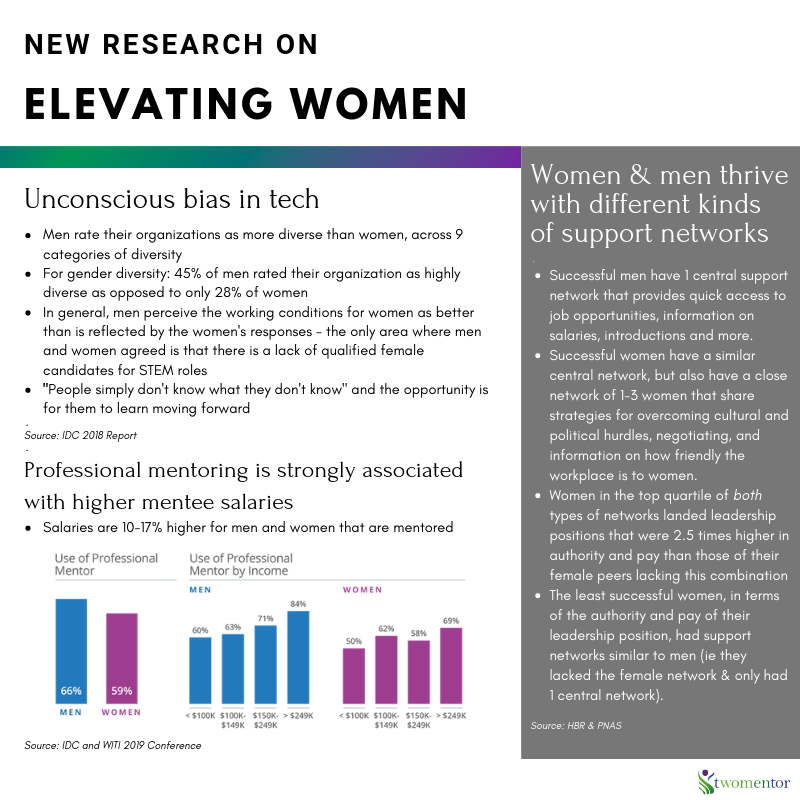by MacKenzie Moore, Director, Twomentor LLC
The fact that women are underrepresented in tech (and STEM jobs in general) is frankly not news: the lack of representation of women and minorities in tech gained visibility 5-7 years ago and exploded when Google and other tech companies released their diversity reports. So, what’s new? Recently, we are seeing new and exciting research pointing to the causes for the lack of diversity and solutions for shifting cultures to advance women in the workplace. Spoiler alert: think unconscious bias and inadequate support networks.
A few weeks ago, Julie Kantor (CEO of Twomentor) was speaking at the Women in Technology International conference where they, in partnership with the IDC, shared compelling evidence for the prevalence and influence of unconscious bias surrounding all forms of diversity in the workplace. The study found that across all nine categories of diversity (ethnic, age, religious, sexual, political, racial, socio-economic, gender and disabilities) men consistently rated their organizations as more diverse that women. The largest gap occurred in gender diversity, with 45% of men rating their organization as very diverse versus only 28% of women.
Across 12 statements on gender diversity and women in tech, men and women only agreed on one: “there is a lack of female candidates for STEM roles.” The responses to the other 11 statements made it clear there is a disconnect between the perception many men have of the working conditions and desires for women in the workplace and the reality reflected in the women’s responses. For example, 22% of men highly agreed with the statement “our workplace culture is geared towards men” versus 45% of women. 42% of men highly agreed with the statement “men and women in STEM roles are paid at approximately the same rate at my organization” as opposed to 24% of women. The authors point out “people simply don’t know what they don’t know” and bringing this unconscious bias to the forefront of education, training and workforce development is critical to elevating women in the workplace.
The IDC and WITI point out a common misconception that women primarily want flexibility in the workplace and job benefits. In reality, the main career gaps for women in tech are compensation and pay, work/life balance and a sense of purpose. These three gaps are closely followed by opportunities for promotion and ongoing skills learning. Given that men hold 75% of all jobs in IT, men play a critical role in filling (or making it possible for women) to fill these career gaps and changing the corporate culture of tech companies.
There is promising news: multiple studies (first a study published last February by the PNAS and now the research from the WITI conference) have shown that one promising method of elevating women in the workplace is providing and facilitating access to adequate support networks and mentorship for women.
WITI and the IDC found that use of a professional mentor is positively correlated with a 10-17% higher income for both men and women. 84% of men who earn above $250,000 have had a mentor as opposed to only 69% of women. Additionally, men with mentors receive more frequent mentorship than women, with 70% of men meeting with their mentors daily or weekly, as opposed to only 29% of women.
Researchers at Northwestern University published a report in the PNAS (see the HBR article here) show that successful men and women have very different support networks. Successful men had social networks with “centrality” – a close circle that shared information on job prospects and employers. Successful women also had high centrality, but they had an additional network of 1-3 women supporting them. The dual network goes beyond providing information on job prospects and employers—it gives them information on corporate culture, how friendly the workplace is to women, and a network to ask for support when challenges arise.
The same study found that women who had strong dual networks (high centrality like men and a female circle) “landed leadership positions that were 2.5 times higher in authority and pay than those of their female peers lacking this combination.” And if women’s networks were most similar to male support networks: high centrality and no inner circle of women, they were placed in leadership positions that were the lowest in authority and pay.
Now, it is important to note that this study was performed on MBA students and not women in tech. More research is needed to confirm that successful women across sectors succeed with similar support networks. However, the needs described by the IDC’s report on women in tech are the focus of women support networks found in the study on MBAs: the women support networks were sharing advice and knowledge of workplace culture, female friendly work policies, lack of work/life balance and opportunities for promotion,
Taken together, these studies show men and women both need to be part of the solution to advancing women in tech. A creative and holistic approach to promoting women in the workplace is necessary. First, address unconscious bias in the workplace. Open up discussions and trainings on unconscious bias in your workplace. Are there pay gaps? Are you providing women with access to a wide array of support networks? Remember, the goal is to give them a way to develop high centrality and to choose a close inner circle of women across all facets of the organization, and in their department.
Mentoring programs targeted to shift corporate culture, create support networks for women, and address unconscious bias are shown to be very effective.
Reach out to the team at Twomentor for best practices, the latest research and a mentoring program customized to your business objectives. Contact: MacKenzie@Twomentor.com

